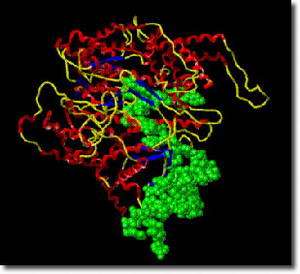Lasers improve scientists’ understanding of complex proteins

By shooting lasers at an RNA polymerase (RNAP) and a strand of DNA, scientists have learned a critical component of how a complex protein develops.
Using a system called fluorescence resonance energy transfer (FRET) on a single molecule, a researcher at the Lawrence Livermore National Laboratory’s Physical Biosciences Institute (PBI) in collaboration with UCLA scientists found that the procedure that regulates genes in a strand of DNA is a single process.
Image: A transcribing T7 RNA polymerase initiation complex. (BioInfo Bank)
Earlier studies done with less precision resulted in scientists believing that the beginning and end phases of RNAP copying a DNA strand into RNA were two different processes.
Using FRET, however, the recent study suggests that “there is no mechanistic difference between the start and finish,” said Ted Laurence of Livermore’s PBI.
RNAP is the molecular machine that serves as a gene transcription tool. When it attaches to a strand of DNA, RNAP transcribes genes to RNA, which then is translated into a protein.
FRET allows scientists to measure distances between two single molecules – a donor and an acceptor – using fluorescence. Molecules have to be less than 8-10 nanometers apart for a FRET to occur.
Using a laser process called ALEX (alternating laser excitation), developed by Laurence, the team looked into the energy transfer of a donor molecule on an RNAP to an acceptor molecule on a strand of DNA.
This was the first time a scientific team was able to confirm that the transcription initiation factor remains on an RNAP throughout the transcription process.
“Because this happens all in one phase, it may be that transcription is regulated even after starting,” Laurence said.
The research appears in the Nov. 11 issue of the journal Molecular Cell.
Source: Lawrence Livermore National Laboratory


















